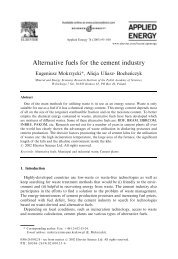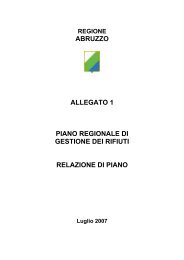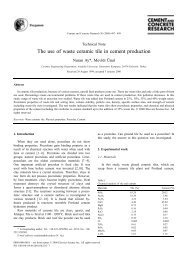GUIDELINES Disposal of Wastes in Cement Plants - BAFU
GUIDELINES Disposal of Wastes in Cement Plants - BAFU
GUIDELINES Disposal of Wastes in Cement Plants - BAFU
You also want an ePaper? Increase the reach of your titles
YUMPU automatically turns print PDFs into web optimized ePapers that Google loves.
<strong>GUIDELINES</strong> <strong>Disposal</strong> <strong>of</strong> Waste <strong>in</strong> <strong>Cement</strong> <strong>Plants</strong> 4<br />
SAEFL will periodically revise the Guidel<strong>in</strong>es, and particularly the "positive list" <strong>in</strong><br />
Appendix I. To this end, it will appo<strong>in</strong>t an expert group compris<strong>in</strong>g representatives <strong>of</strong><br />
the cantons, the cement <strong>in</strong>dustry and the waste <strong>in</strong>dustry, which will convene at least<br />
once a year.<br />
2. Scope <strong>of</strong> the Guidel<strong>in</strong>es<br />
The Guidel<strong>in</strong>es specify which types <strong>of</strong> waste, accord<strong>in</strong>g to Appendix 2, subsection 111,<br />
OAPC 2 , are suitable for the production <strong>of</strong> cement cl<strong>in</strong>ker and Portland cement <strong>in</strong> Swiss plants,<br />
accord<strong>in</strong>g to the SIA norm 215.002 (SN EN 197-1). The Guidel<strong>in</strong>es also conta<strong>in</strong> the<br />
requirements on how this waste must be handled.<br />
Waste may be used for various purposes <strong>in</strong> cement production depend<strong>in</strong>g on its composition<br />
and properties:<br />
a. Use as a fuel, either <strong>in</strong> the ma<strong>in</strong> burner at the cl<strong>in</strong>ker outlet <strong>of</strong> the rotat<strong>in</strong>g kiln or the <strong>in</strong>let<br />
<strong>of</strong> the rotat<strong>in</strong>g kiln.<br />
b. Use as an alternative raw material; this <strong>in</strong>cludes both actual substitution <strong>of</strong> part <strong>of</strong> the<br />
normal raw material and use for any corrective adjustment <strong>of</strong> the elementary composition<br />
<strong>of</strong> the raw meal which may be necessary.<br />
c. Use as constituent at the gr<strong>in</strong>d<strong>in</strong>g stage <strong>in</strong> the production <strong>of</strong> Portland cement.<br />
d. Use as a process material , e.g. aqueous waste that can be used, for example, for flame<br />
cool<strong>in</strong>g for the purpose <strong>of</strong> NO x reduction. Aqueous waste conta<strong>in</strong><strong>in</strong>g ammonia used for<br />
nitric oxide reduction is also <strong>of</strong> <strong>in</strong>creas<strong>in</strong>g importance.<br />
Note:<br />
Many fuels, particularly those <strong>of</strong> low calorific value, conta<strong>in</strong> a significant<br />
proportion <strong>of</strong> <strong>in</strong>combustible, <strong>in</strong>organic substances that are <strong>in</strong>corporated to<br />
100% <strong>in</strong> the product <strong>in</strong>side the cement kiln, i.e. are used as alternative raw<br />
materials (comb<strong>in</strong>ation <strong>of</strong> uses a. and b. above).<br />
3. Requirements for permitted waste<br />
3.1 Basic pr<strong>in</strong>ciples<br />
a) In general, only bulk wastes <strong>of</strong> suitable composition, low <strong>in</strong> pollutants, can be disposed <strong>of</strong><br />
<strong>in</strong> cement plants. This is particularly the case if the quality <strong>of</strong> the waste is comparable with<br />
that <strong>of</strong> the fuels or raw materials customarily used <strong>in</strong> the production <strong>of</strong> Portland cement.<br />
b) Municipal waste and specifically sorted municipal waste fractions (e.g. RDF, "refuse<br />
derived fuel"), as well as other waste comparable to municipal waste with respect to its<br />
orig<strong>in</strong>, material properties, chemical and physical behaviour and chemical composition,<br />
shall not be disposed <strong>of</strong> <strong>in</strong> cement plants if it is not <strong>in</strong>cluded <strong>in</strong> the Positive list (Appendix<br />
I) (the Positive list conta<strong>in</strong>s, for example, used paper and cardboard).<br />
2 Ord<strong>in</strong>ance on Air Pollution Control (OAPC), SR 814.318.142.1, revision <strong>of</strong> 15.12.1997








